Chapter Twenty Nine
Lost City of Hatra
We were visited by Kiu-Nang Mak, the UNDESA section head in charge of the electrical component of the programme in New York, and Michael Higgins, his technical adviser, around August. They started their tour and got the usual hostile reception from the Kurds. Mak fell ill, went into a diabetic coma and was taken to hospital where the doctor there soon had him on his feet again. That night, President Jalal Talabani of Sulaymaniyah invited us to an official reception to meet the Patriarch Raphael I Bidawid, the patriarch of Babylon, who was visiting from Baghdad. We were surprised when Mak arrived at the banquet fully recovered.
Shortly afterwards we were joined by a number of pilots from the Chilean Air Force in their flying gear. These were the only flyers allowed to operate in Iraq with the UN and Saddam’s agreement. Their main function was to fly the UN weapons inspectors around the country. They maintained a few Bell HU-1H Iroquois helicopters at Rasheed Airbase Baghdad and Siddarth Chatterjee, the UN chief in Sulaymaniyah, sent out a call to them when Mak collapsed and asked them to airlift him out.
Mak, who was unaware of the arrangement, was stunned to meet them. The Chileans made the best of the situation and joined in the celebrations with Mak before returning to Baghdad. In fact, when they left Iraq in November 1998 they left their helicopters in Baghdad. I met Jalal Talabani at the reception and had a long chat with him on the subject of parochialism. I waxed lyrical on the rebel spirit and beauty of my native Cork. Cork is known as the Rebel County for obvious reasons and the Red and White colours of its dashing Hurling Team known as the ‘Blood and Bandage’. Hurling, a very fast and skillful game akin to ice hockey and 2,000 years old, is fostered by the Gaelic Athletic Association, the largest amateur games association in the world. Talabani, not to be outdone, sang the praises of Sulaymaniyah. He used to appear frequently on the local TV and give folksy talks to his people from his book-lined study. As a matter of fact I saw him later on satellite TV in my Belgrade apartment giving a similar talk; Talabani is now President of Iraq.
One of the perks arising from visits of VIPs from New York was that we got to see some of the treasures of Iraq as they were shown around. Mak’s visit was no exception and we detoured to visit Hatra on his return trip to Baghdad. Hatra is off the Mosul to Baghdad road about 110 km southwest of Mosul. It is reckoned to be the jewel in the crown of Iraq as regards its state of preservation and its tourist potential. Alas its glory days are long gone and it is now a desert city well off the beaten track. It is much older than Samarra and like it is untouched since its decline, in Hatra’s case for almost 1,700 years. It is a sad lonely sentinel of the desert. It brought to mind Jim Anderson’s ‘The Old House’ whose last verse proclaims:
Lone is the house now and lonely the moorland,
The children are scattered, the old folk are gone,
Why stand I here like a ghost and a shadow?
Tis time I were moving, Tis time I passed on.
Hatra, was founded by Arab tribes about 300 BC. It was one of the finest examples of a Parthian (Persian) city and occupying a strategic position on the border between the rival Roman and Persian Empires was an object of contention between them. In 200 BC it became a fortified city sitting on the famous Silk Road and was situated on the major caravan routes to Palmyra (now Tadmur) in Syria and Asia Minor. The Palmyra route linked it with the great Arab cities, Baalbeck in Lebanon and Petra in Jordan. I had the privilege to work in all of these areas later and explored their ruins. In time Hatra became the capital city of a little kingdom of its own, Araba, and merited its own king. There is a statue of Sanatruq (140-180 AD) who first named himself king with his son Abadsamia (180-205 AD) set in one of the ancient walls of the Temple to Allat an Arabian goddess.
The outer walls were eight kilometres long and the inner ones stretched for six kilometres. A deep defensive moat separated them. These fortifications were so effective that the city withstood two Roman sieges, one by Trajan (116/117 AD) and the second by Septimus Severus (198/199 AD). In this siege the defenders of Hatra are said to have repulsed the Roman Legions by hurling clay pots at them filled with live scorpions.
Hatra defeated the Persians at the battle of Shahrazoor in 238 AD but ceased to be a power after 241 AD when it was razed to the ground by the Saasanid Shapur I, King of the Persian Empire. The traditional story goes that an-Nadira, daughter of the King of Araba, betrayed the city into the hands of Shapur. She married Shapur but he seems to have been fickle as he subsequently had her murdered. Shapur took the fight to the Romans who still menaced the Persian Empire and captured the Roman Emperor Valerian during a meeting at Edessa in 260 AD.
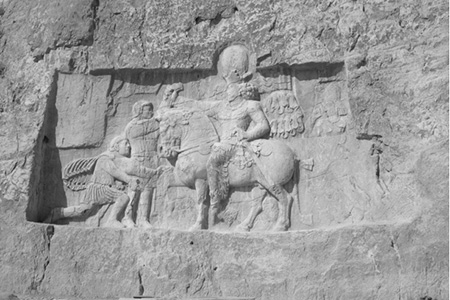
A sculpture at Naqsh-e Rostam, Iran, depicting the triumph of Shapur I over the Roman Emperors Valerian and Peter the Arab. There is confusion as to which of them is kneeling before Shapur.
He humiliated the emperor by exhibiting him in chains, wearing the imperial robes, to the Persian populace. Whenever he mounted his steed he did so by placing his foot on Valerian’s neck. This continued until Valerian, who had the distinction of being the only Roman Emperor to be taken by an enemy, died in Persian captivity.
Hatra was used for the opening scene in the movie The Exorcist. It seems to be otherworldly and evokes none of the sentiments of the old Roman or Mesopotamian ruins simply because we know next to nothing of the people who lived there. It is a world heritage site since 1985 and the Iraqis have been restoring and preserving it since 1950. It is easy to differentiate between the original buildings and the restored stonework of Hatra as each new stone is identified by the raised initials of Saddam Hussein on its surface. Saddam considered himself the equal of the ancient rulers and wanted his power conveyed to succeeding generations in the same way as theirs is. So far the temples that are grouped together in a large complex are being excavated. The residential town of ancient Hatra has not been explored to date.
Being on a trading route, the city was cosmopolitan and had a mix of architectural styles and a pantheon of gods. It has a walled centre complex of temples (temenos) separate from the residential and commercial part of the ancient city and as we approached it we were confronted by an impressive panorama of largely intact ruins.
We entered the Temple complex by the Northern Gate of its east wall and were met at the Temple of Maran (an Aramaic word meaning ‘the Lord’) by a venerable, old, and very dignified gentleman, the guardian of Hatra. He was hugging his old rifle as unobtrusively as possible and quite willing to show us around. When I looked closely it reminded me of a large shopping centre but instead of stores it consisted of a plethora of Temples to the various gods. Hatra must have been a very tolerant city as all these temples co-existed at peace with one another. One could not help comparing it with Bethlehem and Jerusalem in our enlightened age.
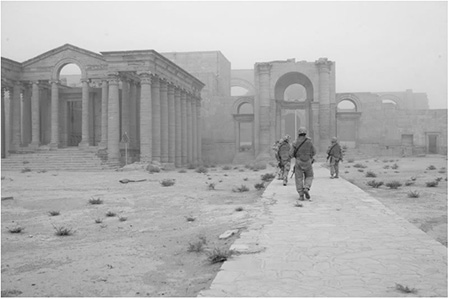
From the new world to the old, US soldiers pass the Temple of Maran to enter the tenenos by the Northern Gate.
Photo: Lance Cpl. Albert F. Hunt/Released, U.S. Marine Corps.
We passed the Hellenistic Temple of Maran and entered the main temples enclosure. The biggest temple by far was the one dedicated to the main regional god Shamash. It was a huge, long, building with eight iwans (large barrel-vaulted arches) and was called the Temple of Baal Shamin (Shamash). The smaller iwans were decorated by the busts of gods, kings and foreign nobles and merchants as if to proclaim the cosmopolitan nature of the city. The Temple of Shamash proper was attached to the back of the line of iwans. Just inside the Temple of Baal Shamin is a relief of a face described as Medusa but may be Shamash himself. Below the head is some Aramaic writing that commemorates the architect of the temple.
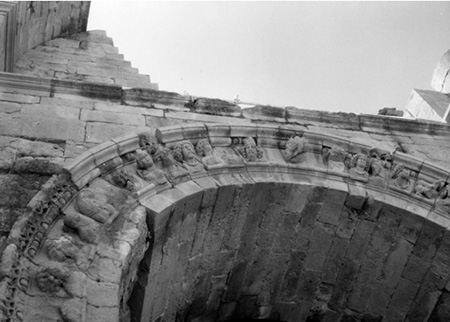
The Arch of Shamash over one of the iwans of his temple. The carved heads of different nationalities show the cosmopolitan character of the city.
There were smaller temples to Nergal, a Sumerian and Akkadian god, to Hermes a Greek god, Atargatis a Syro-Aramaean god, to Allat and Shamiyyah, both Arabian gods and many others. Over the city’s lifetime some gods ‘went out of fashion’ and they were replaced by more modern deities who moved into the old gods’ temples. Hence it is confusing to have a number of gods ascribed to the same temple. In any case we visited as many temples as possible before we had to leave.
Anyone who has spent time in the Middle East would be familiar with the sun and its effect on the environment and the people. In my time in the area its searing heat frequently exceeded 500C. It was an object not to be taken lightly and had to be appeased at all costs so it is easy to see why it became a very important god indeed. It is interesting to know that the Roman Emperor Aurelian brought off some great victories in Syria that he attributed to the help of the sun god. Thereafter he declared that devotion to the sun god was to be the religion of the Roman Empire. The sun god had a number of feast days, one of them, Natalis Invicti (the birth of the invincible one) on December 25th. When Christianity became the religion of the Empire under the Emperor Constantine the Christians decided on December 25th as the birthday of Christ. There was some speculation that there was a connection between the birthday date of Sol Invictus and that of Christ. However, Pope Benedict XVI challenged this theory by arguing that a December 25th date was determined simply by calculating nine months after March 25th regarded as the day of Jesus’s conception (the Feast of the Annunciation). The Christian custom of putting halos over the heads of representations of saints, the circle on our Celtic crosses and the radiate crowns of ancient rulers is also attributed to the sun god. When we exited the temple to Shamash we visited the Temple of the Arabian God Shamiyyah . He seemed to be a popular god as his Temple was superior to most of the gods of the second rank.
There are temples to a number of goddesses principally the Temple of Allat and shrines to the goddess Shahiro (the morning star) and to Tyche (the guardian goddess of Hatra). Allat was the Arab pre-Islamic equivalent of the goddesss Aphrodite. A sculpture of a camel suckling her calf at the entrance to her temple reflects the wealth of Hatra and some say is a symbol of Allat herself.
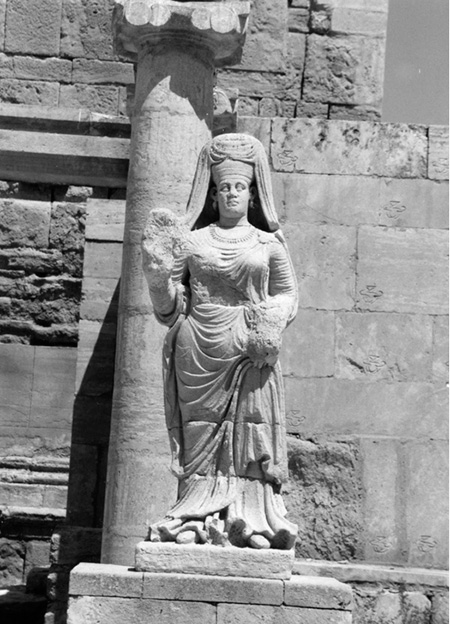
The statue of Abu Bint Deimun, wife of Sanatruz, the first King of Hatra.
No visit to Hatra would be complete without saluting the statue of Abu Bint Deimun, wife of Sanatruz, the first King of Hatra. She is the ‘Venus de Milo’ of Iraq. We were told that the statue in Hatra was a replica, the original is safe in the Museum of Baghdad.
Hatra was an Aramaic city with over 400 Aramaic inscriptions carved on its ruins. Aramaic was the first universal language and was spoken from the Atlantic to the Pacific. Ancient scholars state that it was the language Adam used when he spoke to God and it was used through the generations since. There are many sculptures of eagles around the complex. The eagle was venerated as the city god of Hatra.
There are a number of sculptures of cherubim in the city. In the Assyrian and Babylonian traditions the sky (Heavens) was the abode of the gods and it was supposed that their servants must have wings to get around. These were angels who served the gods as guards or messengers winging their way from the abode of one god to another’s with divine messages. It is common to see a pair of angel-like creatures guarding the doors of ancient palaces and temples. Sometimes they are given the body of a winged bull and the head of a man to emphasise their power. Hence the old kings had sculptures of these creatures within their palaces and temples and at their gates to impress on their subjects that their king was on more than nodding terms with the Gods. The three main religions, Judaism, Christianity and Islam accept the existence of angels principally as messengers of God. In addition in Christian teaching everyone is said to possess an individual guardian angel who nudges them along the path of righteousness. However, there is a school of thought that the ancients borrowed the concept of angels from the Old Testament.
The site at Hatra hid a chilling secret; it was one of Saddam’s killing fields. There in the very spot where he had his name inscribed on building blocks for posterity his troops carried out mass murders of Kurdish villagers. As we strolled around the site and marveled at its wonders we little knew we were walking over graves. In 2003/4 nine trenches were discovered there full of the corpses of Kurds killed by Saddam’s death squads during the 1987/88 Anfal campaign. The victims were separated by sex. In some trenches the blindfolded men were led into the trench and then shot down by automatic gunfire.
The women and children were buried in a separate trench. They were blindfolded and then shot by handguns. The bodies of toddlers had been dealt with in the same manner many of them still holding toys. One toddler still clutched his red and white ball. Many women were shot holding their children to their breast. One child was shot through the back of the head and his mother still clutching him had been shot through the face. Many foetal skeletons were recovered. One was 18 to 20 foetal weeks old when its mother was killed. They had tiny thighbones the size of matchsticks. The women had brought their pots and pans with them. One woman’s severed hand was found in the basket she used to carry her child. When the shooting stopped the bodies were pushed into the trench by bulldozer. When the women’s bodies were unearthed the bright colours of their dresses of red and violet still covered the decayed bodies of their owners. From my point of view this had a more personal impact. In 1987/88 over 300 women and children were brought here from their beautiful village at Dokan Lake and done to death. This was where we often stopped for our picnics as we traveled on the Erbil to Sulaymaniyah road and where I was photographed with the huge thigh bone of a lamb. Dokan was also the site of the Dokan Dam and Hydro Power Station that caused such alarm in the Security Council of the United Nations.
From being one of the high points of my stay in Iraq my trip to Hatra has now become a peak of stomach-churning revulsion. Most mass graves in Iraq and their discovery and exposure were similar. The ones in the north would contain bodies of murdered Kurds, those in the south were of Shias massacred in the insurrection after Operation Desert Storm. The graves at Hatra were dealt with by the US Army Corps of Engineers and the images associated with these graves are heart-rending and were produced at the trial of Saddam Hussein and Chemical Ali. When they were shown to the judges they wept. Saddam defended the killings on the grounds that the Kurds and Shia aided Iran during the Iraq/Iran war. The Hatra images are available on the internet.
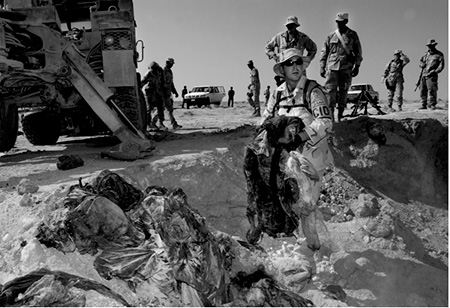
Army Criminal Investigation Command (CID) Special Agent John Massie collects clothing and other belongings found at a mass gravesite at Hatra, Iraq.
Photo: Master Sgt. Robert R. Hargreaves Jr., U.S. Air Force.
Another spin-off from a visit to Iraq of an UN notable was a visit to an UN mine clearance training facility run by UNOPS. Benon Sevan who was an Armenian though born in Cyprus came to Iraq in June 1998 on an inspection visit. Sevan was Assistant Secretary General in the UN Department of Political Affairs and Head of the United Nations Oil for Food Programme.
He visited the three Kurdish governorates and met with the government and their representatives in each one. He was given the usual tour of the UN showcase projects. We visited an agricultural nursery near Dokan and then visited the Dams at Dokan and Derbendikhan. I was asked to accompany him around the site and I briefed him as we toured around.
From Derbendikhan we drove south along the banks of the River Nahr Diyala to reach Fort Maidan where UNOPS sited their Maidan Mines Action Training Centre and Operation Base in one of Saddam’s Russian Forts. When we reached the fort we noticed that the rather grandiose title of the place had almost taken up one complete wall.
The scale of the place was overwhelming. This huge building was literally in the middle of nowhere. It was typical of all the similar forts that the Russians built for Saddam in the Kurdish area. Each one was designed to barrack 10,000 men. When we entered the fort we noticed two large gaps in the opposite sides of the fort made by rockets from Iranian warplanes during the Iran/Iraq war.
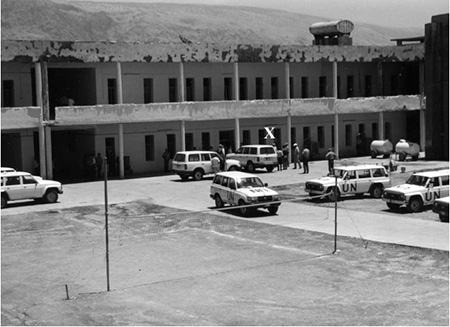
Benon Sevan (Marked X) and his attendants inside Fort Maidan. The Zagros Mountains are in the background.
We were given a lecture on mine clearing and there was a discussion on the mine-detecting dogs that were then coming on stream. The detail that sticks in my mind is that they cost $200,000 each to train.
Twenty five per cent of all the world’s land mines are buried in Iraq. So I had great respect for these mine-clearing squads whose job was mindboggling. They came largely from South Africa and New Zealand and could only drink at weekends when like the cowboys of the Old West they descended on the saloon in the nearest UN club and drank and partied late into the night. I often passed them, as they worked in the minefields off the Erbil-Sulaymaniyah road and in the Zagros Mountains, as they went about their deadly tasks. One cannot praise their professional skills too highly as one is reminded every day as one drives through the cities and towns of Kurdistan of the dreadful affect of mines. There is an hospital in Erbil solely dedicated to dealing with mine victims and it would melt the hardest of hearts to see the distorted and incomplete little bodies facing a dreadful life carrying the scars of these awful and cowardly weapons. After a pep talk by Sevan we returned to base. Most of Saddam’s mines are still in the ground in Kurdistan and brave soldiers are still risking their lives to neutralize them. The UN estimate of their number varies between 10 and 20 million. When Benon Sevan left Erbil he went on to Zakho to inspect the oil pumping station measuring equipment and then departed Iraq.